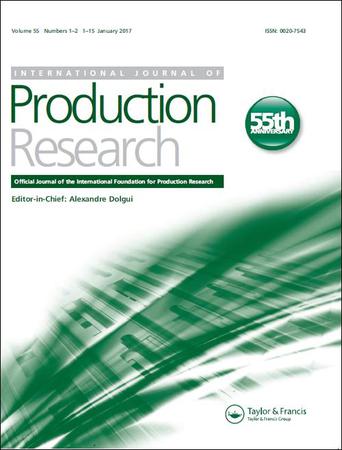具有代换和缺货问题的多层级产能批量问题的数学方法
IF 7.3
2区 工程技术
Q1 ENGINEERING, INDUSTRIAL
International Journal of Production Research
Pub Date : 2023-10-17
DOI:10.1080/00207543.2023.2270076
引用次数: 0
摘要
【摘要】批量问题是生产计划中的一个难点问题,其目的是确定每个生产周期内所要生产的产品及其数量。当考虑到有限的生产能力、物料清单和产品替代等实际问题时,这个问题变得更加复杂。本文研究了一类新的批量问题,即具有替代和延期订货的多级可容批量问题。与以往的研究不同,该变体考虑了产品和组件两个层面的替代,基于制造商增加规划灵活性的实际需求。允许延期交货,但必须在一定时间内交货。我们用数学规划模型来表述这个问题。提出了一种数学方法来解决这个问题。首先使用松弛-修复算法生成初始可行解,然后使用混合修复-优化算法对其进行改进。采用全因子设计实验对算法进行了标定,验证了算法的有效性。最后,通过大量的数值实验,我们分析了这一新的批量问题的性质,如替代选项的影响,以及缺货时间限制的影响,并为制造企业在生产计划中节省成本提供了一些有用的管理见解。关键词:批量问题;替代;后台订单;数学;本研究得到国家重点研发计划项目[资助号:2018YFB1700600]、国家自然科学基金项目[资助号:71971090,71821001]、上海市浦江计划项目[资助号:21PJ1413300]、同济大学中央高校基本科研业务费专项基金的部分支持。胡勤,2011年毕业于香港城市大学,获博士学位。他现任华中科技大学管理学院教授。他目前的研究方向是算法和人工智能领域,包括运筹学中的各种主题,如车辆路线问题、货物分配问题、集装箱装载问题和运输问题。庄浩成,2020年毕业于华中科技大学管理学院,学士学位。他目前在华中科技大学管理学院攻读博士学位。他的工作重点是生产和物流中的组合优化问题。余春龙,上海同济大学机械工程学院助理教授。他获得同济大学学士学位,意大利米兰理工大学硕士学位和博士学位。他目前的研究兴趣是生产计划和调度、仿真优化和制造系统的数据驱动建模。李继流,中国西北工业大学管理学院教授。他获得机械设计、制造与自动化学士学位,管理科学与工程博士学位。主要研究方向为交通运输系统设计与管理、精确算法设计与分析、物流优化、运筹学。他是IJOC, TS, TRB和CIE等期刊的作者和合著者。本文章由计算机程序翻译,如有差异,请以英文原文为准。
A matheuristic approach for the multi-level capacitated lot-sizing problem with substitution and backorder
AbstractThe lot-sizing problem aims at determining the products to be produced and their quantities for each time period, which is a difficult problem in production planning. This problem becomes even more complicated when practical aspects such as limited production capacity, bill of materials, and item substitution are considered. In this paper, we study a new variant of the lot-sizing problem, called the multi-level capacitated lot-sizing problem with substitution and backorder. Unlike previous studies, this variant considers substitutions at both the product and component levels, which is based on the real needs of manufacturers to increase planning flexibility. Backorders are allowed, but should be delivered within a certain time limitation. We formulate this problem using a mathematical programming model. A matheuristic approach is proposed to solve the problem. This first generates an initial feasible solution using a relax-and-fix algorithm, and then improves it using a hybrid fix-and-optimise algorithm. The proposed algorithm is calibrated with a full factorial design of experiments, and its efficiency is well validated. Finally, through extensive numerical experiments, we analyse the properties of this new lot-sizing problem, such as the effect of substitution options, and the influence of backorder time limitation, and provide several useful managerial insights for manufacturing companies to save costs in production planning.KEYWORDS: Lot-sizing problemsubstitutionbackordermatheuristicfix-and-optimiserelax-and-fix Disclosure statementNo potential conflict of interest was reported by the author(s).Data availability statementThe instance data that used in this paper are openly available in https://github.com/ZhuangHaoCheng/MLCLSPSB_Instance.Additional informationFundingThis research was partially supported by the National Key R&D Program of China [grant number 2018YFB1700600], National Natural Science Foundation of China [grant number 71971090,71821001], Shanghai Pujiang Program [grant number 21PJ1413300], and the Tongji University Fundamental Research Funds for the Central Universities.Notes on contributorsHu QinHu Qin received the Ph.D. degree from the City University of Hong Kong, Hong Kong, in 2011. He is currently a Professor with the School of Management, Huazhong University of Science and Technology. His current research interests are in the fields of algorithms and artificial intelligence, including various topics in operations research, such as vehicle routeing problem, freight allocation problem, container loading problems, and transportation problems.Haocheng ZhuangHaocheng Zhuang received B.S. degree from School of Management, Huazhong University of Science and Technology, Wuhan, China, 2020. He is currently pursuing the Ph.D. degree with the School of Management, Huazhong University of Science and Technology. His work focuses on the combinatorial optimisation problems in the production and logistics.Chunlong YuChunlong Yu is an Assistant Professor in the school of mechanical engineering at Tongji University, Shanghai, China. He received a B.Sc. degree from Tongji University, a M.Sc. and a Ph.D. degree from Politecnico di Milano, Milan, Italy. His current research interests are in production planning and scheduling, simulation optimisation, and data-driven modelling of manufacturing systems.Jiliu LiJiliu Li is a Professor with the school of management, Northwestern Polytechnical University, China. He received a B.Sc. in mechanical design, manufacture and automation, a Ph.D. in management science and engineering. His current research interests are in transportation systems design and management, exact algorithm design and analysis, logistics optimisation, operations research. He is the author and co-author of some journal articles in these fields, such as journals IJOC, TS, TRB, and CIE.
求助全文
通过发布文献求助,成功后即可免费获取论文全文。
去求助
来源期刊

International Journal of Production Research
管理科学-工程:工业
CiteScore
19.20
自引率
14.10%
发文量
318
审稿时长
6.3 months
期刊介绍:
The International Journal of Production Research (IJPR), published since 1961, is a well-established, highly successful and leading journal reporting manufacturing, production and operations management research.
IJPR is published 24 times a year and includes papers on innovation management, design of products, manufacturing processes, production and logistics systems. Production economics, the essential behaviour of production resources and systems as well as the complex decision problems that arise in design, management and control of production and logistics systems are considered.
IJPR is a journal for researchers and professors in mechanical engineering, industrial and systems engineering, operations research and management science, and business. It is also an informative reference for industrial managers looking to improve the efficiency and effectiveness of their production systems.
 求助内容:
求助内容: 应助结果提醒方式:
应助结果提醒方式:


